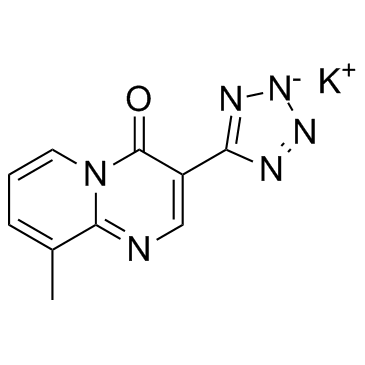Pemirolast potassium

Pemirolast potassium structure
|
Common Name | Pemirolast potassium | ||
|---|---|---|---|---|
| CAS Number | 100299-08-9 | Molecular Weight | 266.301 | |
| Density | N/A | Boiling Point | 454.8ºC at 760mmHg | |
| Molecular Formula | C10H7KN6O | Melting Point | 310-311ºC (dec.) | |
| MSDS | Chinese USA | Flash Point | 228.9ºC | |
| Symbol |

GHS07 |
Signal Word | Warning | |
|
A combined analysis of two studies assessing the ocular comfort of antiallergy ophthalmic agents.
Clin. Ther. 25(4) , 1096-106, (2003) Many topical agents with similar efficacies are available for the treatment of ocular allergies. In addition to efficacy, comfort is an important criterion because it affects overall patient satisfaction, compliance, and in turn efficacy.The goal of this stud... |
|
|
Comparison of 0.1% bromfenac sodium and 0.1% pemirolast potassium for the treatment of allergic conjunctivitis.
Jpn. J. Ophthalmol. 48(6) , 587-90, (2004) We compared the efficacy of a new nonsteroidal antiinflammatory drug (NSAID) eye drop, 0.1% bromfenac sodium (Bromfenac), with that of an antiallergic agent, 0.1% pemirolast potassium (Pemirolast), in the treatment of seasonal allergic conjunctivitis in Japan... |
|
|
Peripheral interstitial keratitis: a novel manifestation of ocular mastocytosis.
Cornea 25(3) , 364-7, (2006) To report a case of peripheral interstitial keratitis in a patient with mastocytosis.Clinical case description and immunohistologic examination of biopsied ocular tissue.A 22-year-old woman with biopsy-proven urticaria pigmentosa, a subset of mastocytosis, pr... |
|
|
Two mast cell stabilizers, pemirolast potassium 0.1% and nedocromil sodium 2%, in the treatment of seasonal allergic conjunctivitis: a comparative study.
Adv. Ther. 20(1) , 31-40, (2003) This randomized, double-masked, active-control, parallel-group trial compared the mast cell stabilizers pemirolast potassium 0.1% and nedocromil sodium 2% in the treatment of seasonal allergic conjunctivitis. Pemirolast is currently indicated for four-times-d... |
|
|
The effect of a combined therapy with a histamine H1 antagonist and a chemical mediator release inhibitor on allergic conjunctivitis.
Ophthalmologica 222(4) , 232-9, (2008) To evaluate the efficacy of a combined therapy with levocabastine hydrochloride ophthalmic suspension and pemirolast potassium ophthalmic solution compared to single therapy with levocabastine hydrochloride ophthalmic suspension alone.Thirty-two allergic conj... |
|
|
New drugs for allergic conjunctivitis.
Med. Lett. Drugs Ther. 42(1077) , 39-40, (2000)
|
|
|
A late cutaneous response in actively sensitized rats: a new method for evaluating the efficacy of antiallergic drugs.
J. Pharmacol. Sci. 101(4) , 350-5, (2006) We established a new and facile model to investigate allergic mechanism and assess the effect of antiallergic compounds. Male Wistar rats were actively or passively sensitized. Active sensitization was performed by injection of both dinitrophenylated-ovalbumi... |
|
|
Increasing effect by simultaneous use of levocabastine and pemirolast on experimental allergic conjunctivitis in rats.
Biol. Pharm. Bull. 28(3) , 473-6, (2005) The effect of the simultaneous use of 0.025% levocabastine hydrochloride eye drops (levocabastine) and 0.1% pemirolast potassium ophthalmic solution (pemirolast) on experimental allergic conjunctivitis in rats was investigated. Levocabastine and pemirolast si... |
|
|
A comparative trial of the safety and efficacy of 0.1 percent pemirolast potassium ophthalmic solution dosed twice or four times a day in patients with seasonal allergic conjunctivitis.
J. Ocul. Pharmacol. Ther. 20(2) , 139-50, (2004) To compare efficacy and safety between twice-daily and four-times-daily regimens of pemirolast 0.1% in allergic conjunctivitis patients.This investigator-masked trial recruited 169 patients, with a positive skin prick test, +2 itching and hyperemia. Patients ... |
|
|
Suppressive activity of pemirolast potassium, an antiallergic drug, on glomerulonephritis. Studies in glomerulonephritis model rats and in patients with chronic glomerulonephritis concurrently affected by allergic rhinitis.
Arzneimittelforschung 58(1) , 18-23, (2008) It is still difficult to manage chronic glomerulonephritis with corticosteroids because of safety concerns, especially for patients with mild symptoms and infants. Therefore, an alternative approach is greatly required. Pemirolast potassium (CAS 100299-08-9) ... |